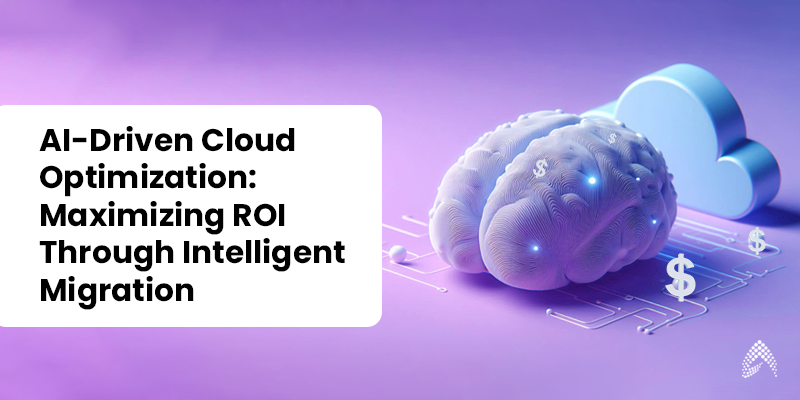
78% of CIOs and other executives have adopted Cloud Solutions in most or all parts of their business: PwC Report, 2023.
What does it mean for you and your business?
It’s simple. If you want to stay relevant and competitive, cloud solutions are no longer a future technology; it’s today’s need. In our regular conversations with business leaders and technologists, they often discuss cloud adoption and its ROI.
Many business owners are now more likely to migrate their on-premises solutions to the cloud to achieve business continuity, security, and scalability at a lower cost.
On the other hand, despite the cloud solutions adoption rate, many businesses have yet to realize the desired outcomes.
Half of the cloud-native transformations are abject failures
– Matt Barrington, emerging technologies leader at EY
Why?
There could be numerous reasons, including lack of a strategy, unpreparedness, lack of internal communication, quick migration, etc.
Cloud migration can seem daunting for many businesses, especially concerns with data security, application compatibility, and the overall migration process. However, by focusing on key strategies and leveraging the right tools, you can migrate to the cloud smoothly and achieve digital transformation goals.

How to Achieve Cloud Migration?
Feeling overwhelmed by cloud migration? You’re not alone. But strategic planning can unlock its benefits: scalability, agility, and cost-efficiency. Here’s how to achieve it:
Infrastructure assessment
- Catalog all existing IT assets including servers, applications, data storage solutions, network configurations, and security protocols.
- Assess current security measures, including firewalls, encryption, and access controls.
- Evaluate the performance of your current infrastructure to identify bottlenecks and areas needing improvement.
- Determine which applications are suitable for migration and their level of complexity.
Setting Objectives
- Define clear, measurable, and SMART goals for the cloud migration project to ensure alignment with business objectives.
- Determine KPIs to measure the success of the migration. Ex: Cost savings, performance metrics, and user satisfaction.
- Enable scalable solutions to handle future growth.
Secure Data Migration
- Plan and assess your data assets for a smooth migration with minimal downtime.
- Ensure data accuracy and security through encryption and regular backups.
- Consider phased migration to minimize risk and maintain business continuity.
Automate Configuration Management
- Ditch manual configuration. Use Infrastructure as Code (IaC) to automate provisioning and deployment in the cloud.
- This reduces human error and ensures consistent infrastructure across your cloud environment.
Optimize Code for the Cloud
- Not all on-premises applications are cloud-ready. Refactor code and leverage cloud-native features for seamless operation.
- Optimize performance and adopt cloud services for enhanced efficiency.
- Ensure code compatibility with your chosen cloud environment for better scalability and reliability.
Low-Code/No-Code for Faster Innovation
- Consider low-code platforms to streamline application migration and integration with cloud services.
- They reduce coding needs and allow developers to focus on integrating pre-built components.
- These platforms offer pre-built connectors and integration tools that simplify the process of integrating legacy systems with new cloud environments.
Automated Testing and Validation
- Implement CI/CD pipelines for continuous integration, automated testing, and delivery.
- This ensures application performance and functionality after migration.
- Conduct security assessments to identify and address any vulnerabilities.
- Incorporate AI to augment your QA testing capabilities and discover unidentified vulnerabilities with traditional testing methods.
Streamlined Program Delivery
- Cloud migration fosters agility and collaboration throughout the development lifecycle.
- Leverage Infrastructure as Code (IaC) and automated deployment pipelines for faster provisioning and configuration changes.
- Embrace containerization technologies like Docker for simplified deployments and consistent application behavior.
- Foster DevOps and Cloud collaboration to identify bottlenecks and optimize the entire delivery process.
Risk Management
- Identify risks related to data security, compliance, downtime, and other factors.
- Assess the risk of data breaches and unauthorized access.
- Implement robust encryption methods for data in transit and at rest.
- Create a comprehensive backup solution and disaster recovery plan to restore operations quickly in case of failure.
- Develop an incident response plan to address potential security breaches
Following these steps can confidently navigate your cloud migration journey and unlock its full potential.
General Electric’s Comprehensive Cloud Migration Journey with AWS
General Electric (GE) undertook a significant cloud migration to enhance its digital transformation and Industrial Internet of Things (IIoT) initiatives. GE transitioned over 9,000 workloads, including critical business applications, to Amazon Web Services (AWS).
Operational Efficiency: The migration streamlined GE’s IT operations, enabling more efficient management and freeing up resources to focus on core business activities.
Cost Reduction: Moving to AWS reduced GE’s operational costs by eliminating the need for maintaining physical servers and data centers, and leveraging a predictable pay-as-you-go model.
Enhanced Agility: The cloud environment allowed GE to quickly scale operations in response to market demands, facilitating rapid deployment of new applications and services.
Leveraging Advanced Analytics and IoT Capabilities
The migration to AWS has empowered GE to harness advanced analytics and IoT capabilities. By integrating these technologies, GE can collect and analyze vast amounts of data from its industrial operations in real-time. This data-driven approach enables predictive maintenance, operational optimization, and improved decision-making, driving efficiency and innovation across GE’s industrial segments.
Case Study
Do you need help managing fragmented business and making timely decisions? You’re not alone. Learn how one of our IT/ Software industry clients built an interactive, cloud-based platform to streamline everything from lead acquisition and nurturing to membership management, all while eliminating the need for data entry and paperwork. Let the AWS solutions reduce your workload by 40%.
Are you considering migrating to the cloud but need help determining where to begin? We’ve got you covered. Connect with our Cloud Migration expert team and get a free consultation to build a seamless cloud migration strategy roadmap.

Author: Venkat Bonam
Director – Global Delivery
Driving innovation and leading high-performance teams to create impactful digital solutions that drive business growth and exceed customer expectations.



